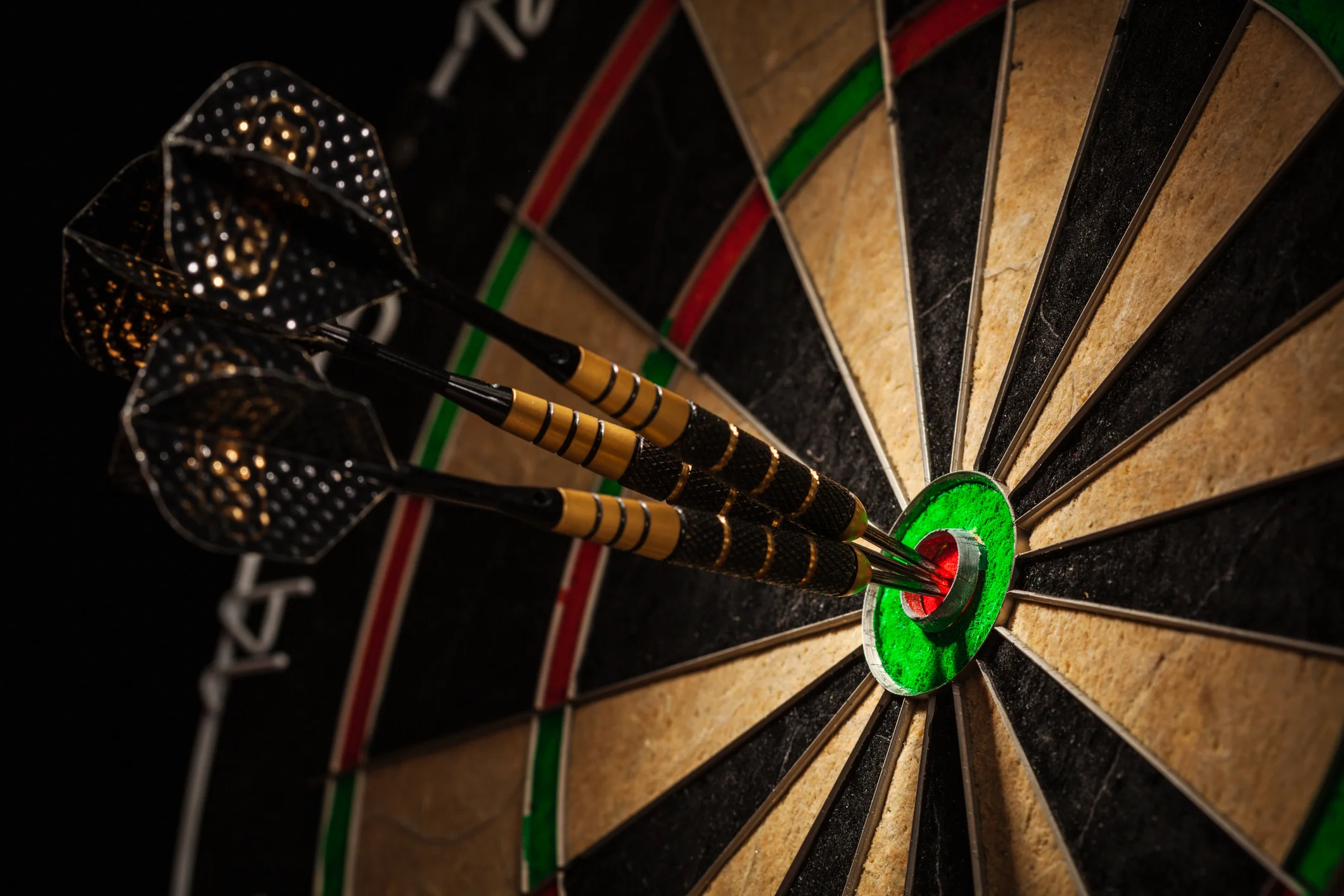
Welcome to our exciting exploration of darts, a game that combines precision, skill, and a bit of friendly competition! Whether you’re a seasoned player or just curious about this popular pastime, we’ve compiled a list of 25 interesting facts that will deepen your appreciation for the sport. From its rich history and unique terminology to the fascinating world of professional tournaments, darts has much more to offer than meets the eye. So grab your darts and let’s dive into the intriguing facts that make this game a favorite among millions around the globe!
The modern game of darts originated in England in the late 19th century. It is believed to have evolved from a game played by soldiers who would throw short arrows at the bottom of a wine barrel. Over time, this practice led to the creation of the dartboard, and the game gained popularity in pubs and social gatherings. The first official rules were established in the 1900s, and the game has since developed into a competitive sport with organized tournaments and professional players.
The standard dartboard is divided into 20 numbered sections, with the bullseye at the center. Each section is arranged in a specific order to create a challenging game. The numbers on the board are not sequential; they are designed to penalize players for missing their target. For example, the number 20 is located directly opposite the number 1, making it more difficult to aim accurately. The bullseye, located in the center, is the most coveted target, as it offers the highest points.
The distance from the throw line (oche) to the dartboard is 7 feet 9.25 inches (2.37 meters). This measurement is standardized for both professional and amateur play, ensuring consistency in the game. Players must stand behind this line when throwing darts, which adds an element of skill and precision. The height of the dartboard is also standardized, set at 5 feet 8 inches (1.73 meters) from the floor to the center of the bullseye, making it accessible for players of various heights.
The bullseye is worth 50 points, while the outer bullseye is worth 25 points. The bullseye is the most valuable target on the board, and hitting it can significantly boost a player’s score. The outer bullseye, which is a ring surrounding the center, offers a lower score but is still a desirable target. In competitive play, players often strategize their throws to maximize points, especially when they are close to finishing a game.
A standard dart weighs between 16 and 30 grams. The weight of the dart can influence a player’s throwing style and accuracy. Heavier darts tend to be more stable in flight but may require more strength to throw effectively. Conversely, lighter darts can be thrown with less force but may be more susceptible to wind or other environmental factors. Players often experiment with different weights to find the best fit for their style.
The World Darts Championship has been held annually since 1978. This prestigious event is organized by the Professional Darts Corporation (PDC) and attracts the best players from around the world. The tournament features a knockout format, culminating in a final match that determines the world champion. The event has grown in popularity over the years, with millions of viewers tuning in to watch the action, and it has become a highlight of the darts calendar.
The Professional Darts Corporation (PDC) is the leading organization for professional darts. Founded in 1992, the PDC has played a crucial role in popularizing the sport and elevating its status to that of a professional competition. The organization hosts numerous tournaments throughout the year, including the World Darts Championship, and has developed a ranking system for players. The PDC has also expanded the sport’s reach by promoting events internationally and attracting sponsorship deals.
The highest score possible with three darts is 180, achieved by hitting three triple 20s. This feat is considered the pinnacle of scoring in darts and is celebrated by players and fans alike. The triple 20 segment is the smallest target on the board, making it a challenging goal to hit consistently. Players often strive for this score during crucial moments in a match, and achieving a 180 can shift the momentum in their favor.
The first televised darts match took place in 1973. This historic event marked a turning point for the sport, as it introduced darts to a wider audience and showcased the skills of professional players. The match was broadcast on the BBC, leading to increased interest in the game and paving the way for future televised tournaments. Over the years, the visibility of darts has grown, with major events now attracting large television audiences and sponsorship deals.
The term “nine-dart finish” refers to the minimum number of darts needed to finish a game from 501 to zero. Achieving a nine-dart finish is a rare and impressive accomplishment in darts, showcasing a player’s skill and precision. This finish requires a combination of hitting high-scoring segments, such as triple 20s and doubles, in a specific order. Players who achieve this feat often receive significant recognition and acclaim within the darts community.
Phil Taylor holds the record for the most World Championship titles, with 16 wins. Taylor, known as “The Power,” is widely regarded as one of the greatest darts players of all time. His dominance in the sport spanned over two decades, during which he showcased exceptional skill, consistency, and mental toughness. Taylor’s ability to perform under pressure, particularly in high-stakes matches, contributed to his remarkable success and cemented his legacy in darts history.
The game of darts is played in various formats, including 501, 301, and cricket. The most common format, 501, begins with each player starting with a score of 501 and aiming to reduce their score to zero by hitting specific targets. In 301, players start with 301 points and must also finish on a double. Cricket is a different style where players aim to hit specific numbers (15 through 20 and the bullseye) to score points while also closing out their targets before their opponent. Each format has its own set of strategies and rules, appealing to different types of players.
The first World Darts Championship was held at the Circus Tavern in Purfleet, Essex. This inaugural event in 1978 marked the beginning of organized professional darts and featured a small number of competitors. The tournament was a significant milestone, as it helped to establish darts as a legitimate sport and provided a platform for players to showcase their talents. Over the years, the championship has grown in scale and prestige, moving to larger venues and attracting top players from around the world.
Darts became an official sport in the UK in 2005. This recognition helped to elevate the status of darts and provided a framework for its governance and development. The official designation allowed for better organization of tournaments and increased funding for grassroots initiatives. It also helped to promote darts as a sport that requires skill, strategy, and athleticism, further enhancing its appeal to a broader audience.
The world record for the fastest 501 finish is 9.57 seconds, set by a player named Paul Lim. This incredible achievement highlights Lim’s exceptional skill and precision in throwing darts. To accomplish such a rapid finish, a player must hit a combination of high-scoring segments, including triple 20s, and finish on a double, all while maintaining perfect accuracy. Lim’s record is a testament to the high level of competition in darts and the potential for extraordinary performances.
The most popular dart material is tungsten, known for its density and durability. Tungsten darts are favored by many professional players because they can be made thinner than darts made from other materials while maintaining the same weight. This allows for tighter grouping of darts on the board, leading to higher scores. The use of tungsten has revolutionized dart design, enabling players to choose from a variety of styles and weights to suit their throwing preferences.
The World Darts Federation (WDF) governs international darts competitions. Founded in 1976, the WDF oversees the rules and regulations of the sport at the global level, ensuring consistency and fairness in competitions. The organization also promotes darts worldwide, organizing tournaments and events that showcase players from different countries. The WDF plays a crucial role in developing the sport and fostering international competition, contributing to its growth and popularity.
A “double” is required to win a game of 501, meaning a player must land their final dart in a double segment. This rule adds an element of strategy to the game, as players must carefully plan their approach to finishing. Hitting a double can be challenging, especially under pressure, and requires a combination of skill and mental focus. Players often practice their doubles extensively, as finishing on a double is a critical aspect of winning matches.
The average professional darts player can throw a dart with an accuracy of around 50% to the intended target. This statistic highlights the high level of skill required to compete at a professional level. Players must develop consistent throwing techniques, focus, and muscle memory to achieve such accuracy. Factors such as stance, grip, and release all play a significant role in a player’s ability to hit their targets consistently, making practice and training essential for success.
Darts is played in over 70 countries worldwide. The sport’s global reach has contributed to its popularity and the emergence of various international competitions. Countries such as the UK, the Netherlands, and Australia have strong darts traditions, with many professional players emerging from these regions. The international nature of the sport fosters camaraderie and competition among players from diverse backgrounds, further enhancing the appeal of darts on a global scale.
The first-ever darts world champion was Leighton Rees from Wales in 1978. Rees’s victory in the inaugural World Darts Championship marked a significant milestone in the history of the sport. His skill and determination set the stage for future competitions and inspired a generation of players. Rees was known for his steady hand and precise throwing technique, which helped him secure his place in darts history. His win not only elevated his status as a player but also contributed to the growing popularity of darts as a competitive sport.
The “oche” is the line behind which players must stand when throwing darts. The oche is a critical element of the game, as it establishes the proper distance from the dartboard, which is set at 7 feet 9.25 inches (2.37 meters). Players must remain behind this line to ensure fair play and maintain the integrity of the game. The oche can be marked on the floor with tape or a permanent line, and players often develop a routine that includes their stance and approach to the oche before making their throws.
The game is often played in pubs and social clubs, contributing to its popularity. Darts has a rich tradition as a social pastime, often enjoyed in friendly competition among friends and patrons in local establishments. The relaxed atmosphere of pubs allows players of all skill levels to participate, making it accessible and enjoyable for everyone. Many pubs host leagues and tournaments, fostering a sense of community and camaraderie among players. This social aspect has played a significant role in the sport’s growth and enduring appeal.
The largest darts tournament is the PDC World Darts Championship, with a prize fund of over £2.5 million. This prestigious event attracts the best players from around the world and features a knockout format that culminates in a final match to determine the champion. The substantial prize fund reflects the tournament’s significance in the darts calendar and the increasing commercial interest in the sport. The PDC World Darts Championship has become a showcase for top talent, drawing large audiences both in-person and through broadcasts.
The game of darts has been featured in the Olympics as a demonstration sport, but it is not yet an official Olympic sport. While darts has gained considerable popularity and recognition, it has not yet achieved the status of an Olympic sport. The inclusion of darts as a demonstration event has helped raise awareness and interest in the game on a global scale. Advocates for darts continue to push for its inclusion in future Olympic Games, emphasizing the sport’s skill, strategy, and competitive nature.
Frequently Asked Questions About Darts
Basic Darts Questions
- What are the different types of darts? There are primarily two types of darts:
- Steel-tip darts: These are used for professional play and require a specific dartboard with a wire mesh. They provide a more traditional and precise experience.
- Soft-tip darts: These are used with electronic dartboards. They have softer, plastic tips and are safer for home use.
- How do I score in darts? A standard dartboard is divided into numbered segments. Each segment has a single, double, and triple scoring area.
- Single: Hitting the number directly.
- Double: Hitting the outer ring of a number.
- Triple: Hitting the inner ring of a number.
- What are the most common dart games? Some of the most popular dart games include:
- 501: Players start with 501 points and aim to reduce their score to zero by throwing darts at the board. The last dart must hit a double.
- Cricket: Players aim to close numbers by hitting them three times each. Once closed, additional points can be scored on those numbers.
- 301: Similar to 501, but players start with 301 points.
Dart Equipment and Setup
- What are the components of a dart? A dart typically consists of three parts:
- Point: The sharp tip that penetrates the dartboard.
- Shaft: The cylindrical part connecting the point and barrel.
- Flight: The flat, aerodynamic part at the rear of the dart, stabilizing its flight.
- How do I choose the right dart weight? Dart weight is a personal preference. Generally, beginners may start with heavier darts (around 22-24 grams) for better control. As you improve, you might switch to lighter darts for faster throws.
- How far should I stand from the dartboard? The standard distance for professional darts is 7 feet 9.25 inches (2.37 meters). However, for casual play, you can adjust the distance based on your preference and skill level.
Dart Tips and Techniques
- How do I improve my dart throw? Practice is key. Focus on a consistent grip, release, and follow-through. Consider taking lessons from a professional darts player or coach.
- How do I avoid bouncing darts? Ensure you’re throwing with the correct angle and force. Avoid throwing too hard, as this can cause the dart to bounce off the board.
- How do I improve my accuracy? Practice aiming at specific targets, such as the bullseye or a particular number. Visualization techniques can also help improve your accuracy.
Darts Etiquette and Sportsmanship
- What is the proper dartboard etiquette?
- Avoid distracting other players.
- Be respectful of the equipment and the playing area.
- Don’t touch the dartboard while others are throwing.
- Be a good sport, win or lose.
- How can I join a darts league? Check with local pubs, sports bars, or dart clubs in your area. Many leagues have open divisions for players of all skill levels.
By understanding these fundamental aspects of darts, you can enhance your enjoyment of the game and improve your skills.








